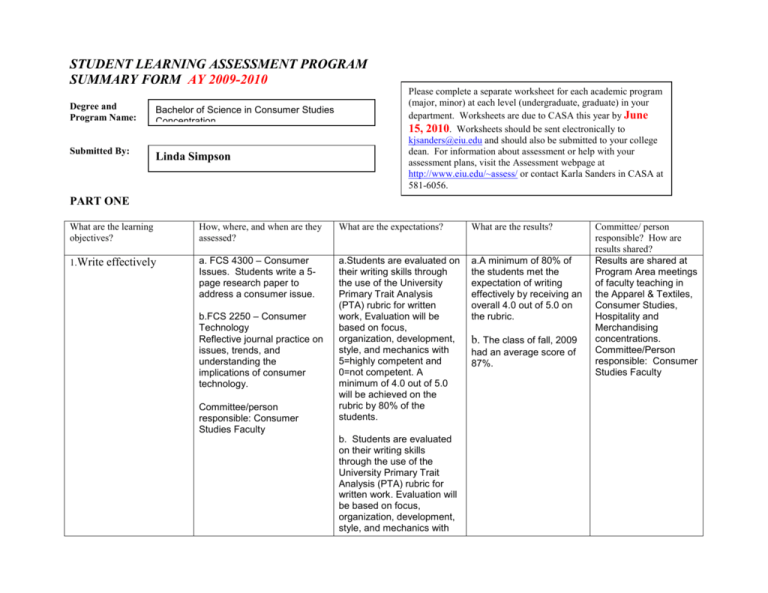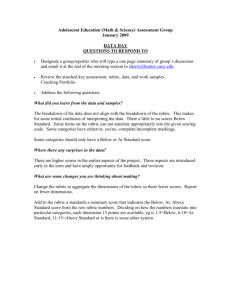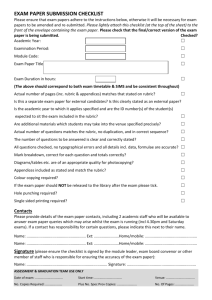Submitted By
advertisement

STUDENT LEARNING ASSESSMENT PROGRAM SUMMARY FORM AY 2009-2010 Degree and Program Name: Submitted By: Bachelor of Science in Consumer Studies Concentration Linda Simpson Please complete a separate worksheet for each academic program (major, minor) at each level (undergraduate, graduate) in your department. Worksheets are due to CASA this year by June 15, 2010. Worksheets should be sent electronically to kjsanders@eiu.edu and should also be submitted to your college dean. For information about assessment or help with your assessment plans, visit the Assessment webpage at http://www.eiu.edu/~assess/ or contact Karla Sanders in CASA at 581-6056. PART ONE What are the learning objectives? How, where, and when are they assessed? What are the expectations? What are the results? 1.Write effectively a. FCS 4300 – Consumer Issues. Students write a 5page research paper to address a consumer issue. a.Students are evaluated on their writing skills through the use of the University Primary Trait Analysis (PTA) rubric for written work, Evaluation will be based on focus, organization, development, style, and mechanics with 5=highly competent and 0=not competent. A minimum of 4.0 out of 5.0 will be achieved on the rubric by 80% of the students. a.A minimum of 80% of the students met the expectation of writing effectively by receiving an overall 4.0 out of 5.0 on the rubric. b.FCS 2250 – Consumer Technology Reflective journal practice on issues, trends, and understanding the implications of consumer technology. Committee/person responsible: Consumer Studies Faculty b. Students are evaluated on their writing skills through the use of the University Primary Trait Analysis (PTA) rubric for written work. Evaluation will be based on focus, organization, development, style, and mechanics with b. The class of fall, 2009 had an average score of 87%. Committee/ person responsible? How are results shared? Results are shared at Program Area meetings of faculty teaching in the Apparel & Textiles, Consumer Studies, Hospitality and Merchandising concentrations. Committee/Person responsible: Consumer Studies Faculty 5=highly competent and 0=not competent. A minimum of 4.0 out of 5.0 will be achieved on the rubric by 80% of the students. 2. Speak effectively a.FCS 2244 Consumer Textiles – Class discussion b. FCS 4300 – Consumer Issues. Develop a 25 minute presentation on a current consumer issue. c.FCS 2250 – Consumer Technology. Discussion and debate of issues was a focus of every class session. Committee/person responsible: Consumer Studies Faculty a.Students determine how textile purchases change throughout the life cycle. Students discuss and present their findings and determine the different family scenarios that could affect these purchases, ex. divorce, step children/siblings, grandparents raising grandchildren, etc. Family Systems Theory is discussed as children generally model spending patterns of their parents. A minimum of 4.0 out of 5.0 on The University Rubric to Assess Individual and Group Presentations will be achieved on the rubric by 80% of the students. b. Students will choose a consumer issue to report on and will facilitate class discussion and/or debate. The University Rubric to Assess Individual and a.The results were positive with 90% of the students completing the work to 90-100% grade. Rubric score of 4./5.0 b.The results were positive with 80% of the students completing the work to 90-100% grade. Rubric score of 4.0/5.0 c. Assignments centered around these discussion topics averaged out to be 85.5% Results are shared at Program Area meetings of faculty teaching in the Apparel & Textiles, Consumer Studies, Hospitality and Merchandising concentrations. Committee/Person responsible: Consumer Studies Faculty Group Presentations will be used. The following criterion will be examined: language, material, analysis, nonverbal delivery, and verbal delivery. A minimum of 4.0 out of 5.0 will be achieved on the rubric by 80% of the students. c. Discussion and debate of issues is a focus of every class session. The University Rubric to Assess Individual and Group Presentations will be used. A minimum of 4.0 out of 5.0 will be achieved on the rubric by 80% of the students 3. Think critically a.FCS 4300 - Consumer Issues. Students solve a consumer problem b. FCS 3300 Consumer Education and FCS 4770 Consumer Decisions in the Marketplace. Historical perspective of consumer trends c. FCS 3300 – Consumer Education: Students conduct an evaluation of a minimum of 3 products and services. a. Students present findings and peers discuss and analyze the problem. The University Rubric to Assess Individual and Group Presentations will be used. A minimum of 4.0 out of 5.0 will be achieved on the rubric by 80% of the students b. Students reflect on the history of the consumer and how/why the various laws, such as Food and Drug Act, were implemented. This The results were positive with 85% of the students completing the work to 90-100% grade. Rubric score 4/5.0 a. b. The results were positive with 80% of the students completing the work to 90-100% grade. Rubric score 4/5.0 Results are shared at Program Area meetings of faculty teaching in the Apparel & Textiles, Consumer Studies, Hospitality and Merchandising concentrations. Committee/Person responsible: Consumer Studies Faculty d. Consumer Studies Concentration Senior Exit Survey was used to assess the competence to think critically Question 26 on the exit survey. Committee/person responsible: Consumer Studies Faculty discussion includes trends in the economy, family structure, food processing, product development, etc. The University Rubric to Assess Individual and Group Presentations will be used. A minimum of 4.0 out of 5.0 will be achieved on the rubric by 80% of the students c.Students evaluated on their consumer research evaluation skills through the use of the University Primary Trait Analysis (PTA) rubric for written work. Students will determine the quality indicators examined for each product or service and provide a summary and recommendation. Evaluation will be based on focus, organization, development, style, and mechanics with 5=highly competent and 0=not competent. A minimum of 90% will be achieved by 90% of the students. d. a minimum mean score of 4/5 (4=Agree; 5=Strong Agree) (n=5) for question #26 on the exit survey that reads: My skills related to evaluation of consumer products and services are sufficient to meet consumer affairs position requirements. c.The results were positive with 90% of the students completing the work to 90-100% grade. Rubric score of 4./5.0 d. A mean score of 4.0 out of 5 (Strongly Agree) (n=19) reported that their skills related to evaluation of consumer products and services are sufficient to meet consumer affairs position requirements. 4.0 out of 5.0 (n=3) 4. Function as responsible global citizens. a.Consumer Studies Concentration Senior Exit Survey was used to assess the competence in functioning as a responsible global citizen. Question 19 on the exit survey. Committee/person responsible: Consumer Studies Faculty a. a minimum mean score of 4/5 (4=Agree; 5=Strong Agree) (n=5) for question #26 on the exit survey that reads: During my time at EIU I participated in a least one campus program or seminar about diversity, international issues or global relations. a. A mean score of 4.0 out of 5 (Strongly Agree) (n=19) reported that their sensitivity to diversity of consumers has developed appropriately to meet the consumer studies position requirements. Results are shared at Program Area meetings of faculty teaching in the Apparel & Textiles, Consumer Studies, Hospitality and Merchandising concentrations. Committee/Person responsible: Consumer Studies Faculty (Continue objectives as needed. Cells will expand to accommodate your text.) PART TWO Describe what your program’s assessment accomplishments since your last report was submitted. Discuss ways in which you have responded to the CASA Director’s comments on last year’s report or simply describe what assessment work was initiated, continued, or completed. In response to CASL trying to address the concern of the Higher Learning Commission that more of our undergraduate goals be assessed at the major level as well as the University level, the following goals were addressed this year: to write effectively, to speak effectively, to think critically, and to function as responsible global citizens. As suggested by Dr. Sanders, a feedback loop continues to be used to share the results of the program to faculty via Program Area meetings. PART THREE Summarize changes and improvements in curriculum, instruction, and learning that have resulted from the implementation of your assessment program. How have you used the data? What have you learned? In light of what you have learned through your assessment efforts this year and in past years, what are your plans for the future? In 2009, Dr. Sanders suggested that it was unclear how the assignments from various courses will be assessed; therefore, she suggested the development of a rubric for such measures to determine the certain degree of competence. The use of rubrics for assessment has served as a guide to ensure that all sections of the courses taught are assessed using the same criterion. This use of rubrics has been extremely beneficial to the Consumer Studies’ faculty. Questions on the Senior Exit Survey addressed two of the four goals: to think critically and to function as a responsible global citizen. The following two questions will be added to the 2010-11 Senior Exit survey to address writing and speaking skills: 1. My ability to write effectively and efficiently has improved as a result of my consumer studies coursework. 2. My ability to effectively communicate verbally has improved as a result of my consumer studies coursework.






